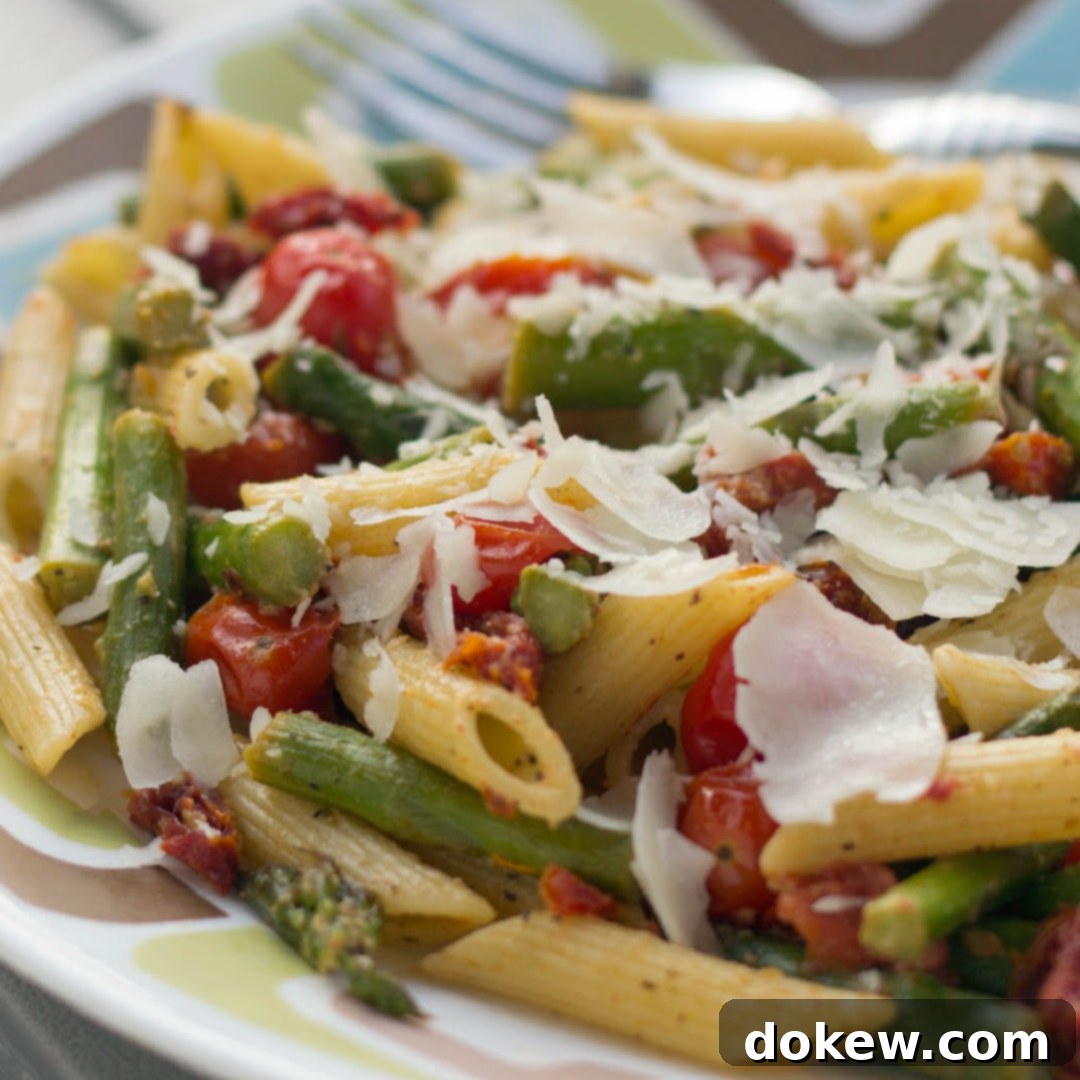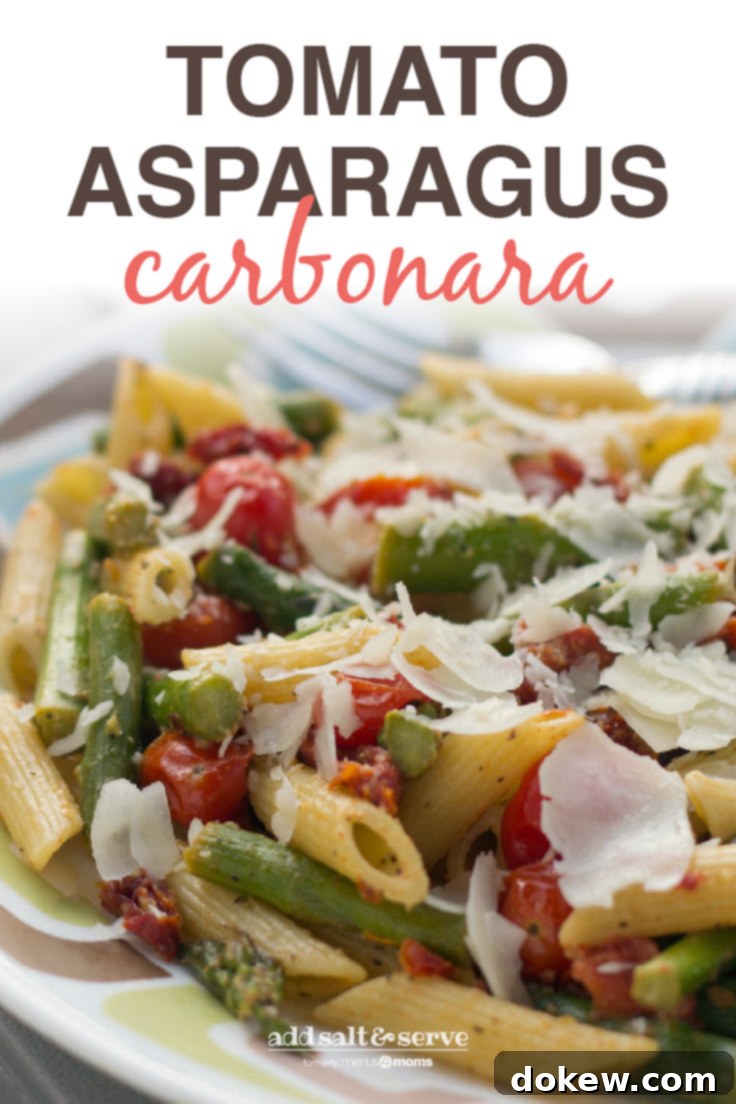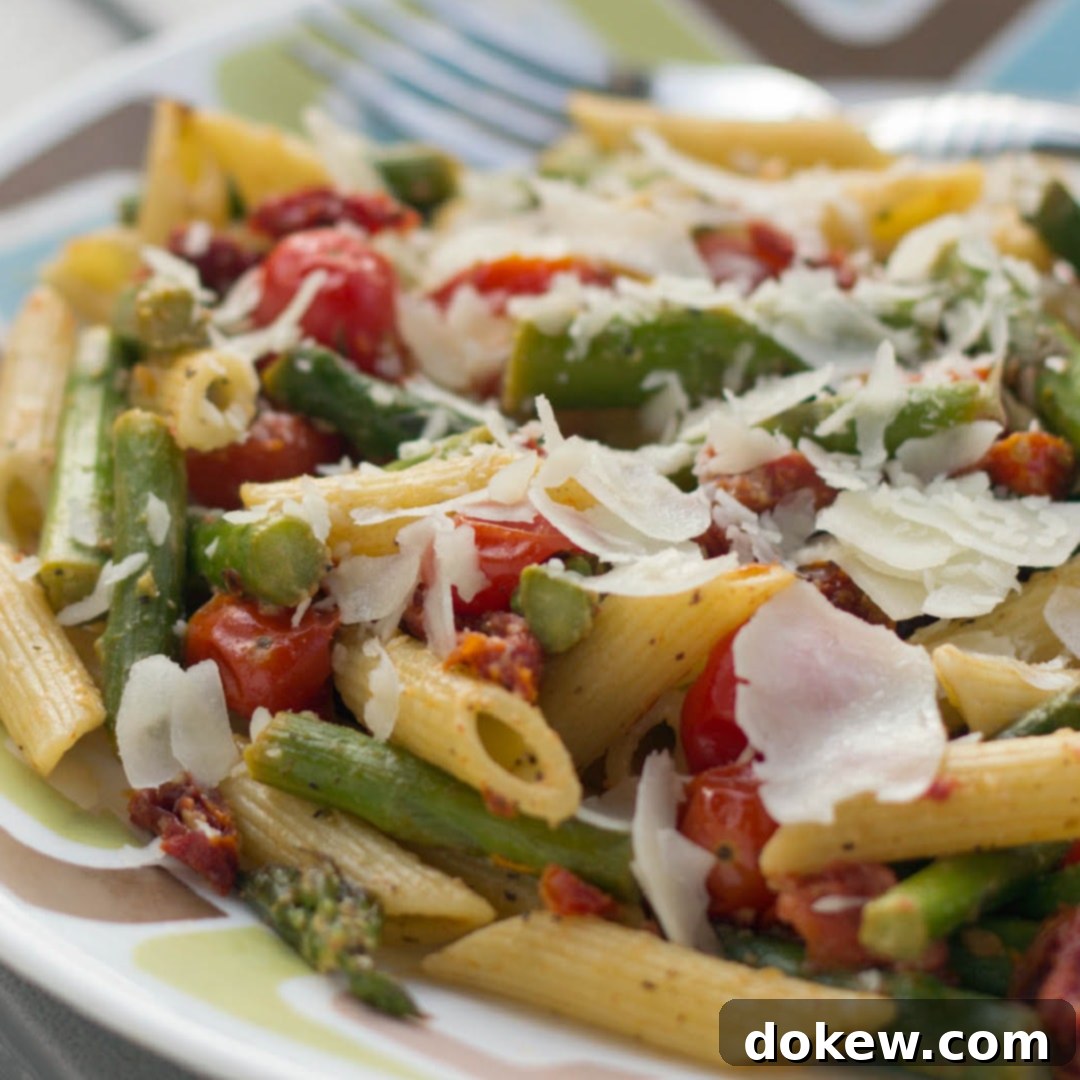Fresh & Flavorful Tomato and Asparagus Carbonara: Your Guide to a Perfect Summer Pasta Dish
Carbonara, at its heart, is a quintessential Italian pasta dish renowned for its rich, creamy sauce, traditionally achieved without any cream at all. Instead, it relies on the ingenious combination of hot pasta, whisked eggs, a generous helping of hard cheese (like the classic Pecorino Romano), and freshly ground black pepper. The residual heat from the freshly cooked pasta gently cooks the raw egg, transforming it into a luxurious, silken coating that beautifully adheres to every strand. While Pecorino Romano is the traditional choice in Italy, many in the United States often opt for Parmesan cheese due to its wider availability and slightly milder flavor profile, making it a versatile substitute.
This traditional foundation becomes a canvas for seasonal creativity in our Tomato and Asparagus Carbonara. By incorporating vibrant, garden-fresh vegetables, we elevate the classic into a lighter, more refreshing meal perfect for warmer months or when you simply crave a burst of fresh flavor. This recipe strikes a delightful balance, offering the comforting richness of carbonara while celebrating the crisp tenderness of asparagus and the sweet tang of ripe tomatoes.
One of the foundational secrets to any great pasta dish, and especially carbonara, lies in the way the pasta is cooked. Always use generously salted water. Think of it like seasoning your food from the inside out; the pasta absorbs the salt as it cooks, enhancing its flavor significantly. A good rule of thumb is that the shorter the cooking time for the pasta, the more heavily the water should be salted, ensuring maximum flavor infusion in a shorter window.

Recipe: Tomato and Asparagus Carbonara

Tomato and Asparagus Carbonara
Add to Shopping ListGo to Shopping List
Ingredients
- 1 tablespoon olive oil
- 1 Lb asparagus, trimmed and cut into 1 inch pieces
- 2 teaspoon garlic, minced
- ¼ teaspoon crushed red pepper flakes, optional
- 1 cup grape tomatoes, cut in half
- ½ cup sun-dried tomatoes packed in oil, drained
- 8 oz. penne pasta
- 1 teaspoon salt, for boiling pasta
- ½ teaspoon salt
- ½ teaspoon pepper
- 1 egg
- ½ cup Parmesan cheese, plus more for garnish
- ¼ cup basil, fresh
Instructions
-
Cook pasta in water with 1 tsp. of salt until al dente.
-
Heat oil in a large skillet over medium-high heat. Add asparagus and sauté about 3 minutes.
-
Add garlic and crushed red pepper, cooking for another minute.
-
Reduce heat to medium and add all tomatoes; cook for 6 minutes or until grape tomatoes are tender. Stir gently to avoid crushing the tomatoes.
-
Whisk egg with ½ cup Parmesan cheese, salt, and pepper.
-
Drain pasta and toss hot, cooked pasta with egg mixture.
-
Add tomato mixture, tossing gently until sauce thickens. Serve in shallow bowls and sprinkle each serving with chopped fresh basil and Parmesan cheese.
Notes
- To prepare asparagus, rinse it under running water, then hold it with both hands and snap off the tough end. Hold the stalk so that the hand on the tip end is closer to the center of the stalk and the hand on the cut end is close to the end of the stalk. Bring your hands down and toward each other, and the stalk will snap just where it starts to get tough at the end.
- The heat from adding the egg mixture to the hot pasta will cook the egg, thickening it into a light, creamy sauce.
- Parmesan garnish not included in nutritional data.
Nutrition per serving
Share
Pin
Understanding the Magic of Carbonara
While often mistaken for a cream-based sauce, authentic Carbonara achieves its incredible richness through a delicate emulsion of egg yolks (sometimes whole eggs), finely grated hard cheese, cured pork (like guanciale or pancetta), and a touch of the starchy pasta water. This interaction creates a luxurious, velvety sauce that clings beautifully to the pasta. The key is to incorporate the egg mixture off the heat, or over very low heat, using the pasta’s residual warmth to thicken the sauce without scrambling the eggs. Our Tomato and Asparagus Carbonara recipe embraces this same technique, ensuring a truly authentic texture and flavor, even with the addition of fresh vegetables.
Why Choose Tomato and Asparagus for Your Carbonara?
The addition of asparagus and tomatoes transforms traditional carbonara into a vibrant, vegetarian-friendly dish that shines with seasonal produce. Asparagus brings a delicate earthy flavor and a pleasing crisp-tender texture, providing a wonderful contrast to the creamy sauce. Tomatoes, especially sweet grape tomatoes and rich sun-dried tomatoes, add layers of flavor: the fresh grape tomatoes burst with juicy sweetness, while the sun-dried tomatoes introduce a concentrated umami depth that complements the cheese beautifully. This combination makes for a pasta dish that feels both indulgent and surprisingly light, perfect for a weeknight dinner or a special summer gathering.
Ingredient Deep Dive: What Makes This Dish Sing
- Olive Oil: The foundation for sautéing. Use a good quality extra virgin olive oil for flavor.
- Asparagus: Freshness is key. Look for firm, bright green stalks. Trimming the tough ends (as detailed in the notes) ensures tender bites. Cutting them into 1-inch pieces allows them to cook quickly and integrate well with the pasta.
- Garlic: Essential aromatic. Minced garlic infuses the oil with its pungent, savory notes.
- Crushed Red Pepper Flakes (Optional): A touch of heat can elevate the dish, balancing the richness of the carbonara. Adjust to your preference.
- Grape Tomatoes: Halved, these add pops of fresh, juicy sweetness and acidity, cutting through the richness of the sauce.
- Sun-Dried Tomatoes Packed in Oil: These are flavor bombs! They provide intense umami and a chewy texture, adding complexity that fresh tomatoes alone can’t achieve. Draining them prevents excess oil in the sauce.
- Penne Pasta: The tubular shape of penne is fantastic for catching and holding the creamy sauce and small vegetable pieces. Other short pasta shapes like rigatoni or fusilli would also work well.
- Salt (for boiling pasta): Crucial for seasoning the pasta itself. Don’t skimp! It should taste like seawater.
- Salt & Pepper (for seasoning): Fine-tune the flavor of the overall dish. Freshly ground black pepper is always recommended for a more pungent aroma.
- Egg: The heart of carbonara. This recipe uses one egg, which creates a lighter sauce. For an even richer sauce, you could use two egg yolks and one whole egg, but for this fresh, veggie-forward version, one whole egg is often sufficient.
- Parmesan Cheese: Our chosen hard cheese for its nutty, savory flavor. Use freshly grated for best results. It’s crucial for the sauce’s texture and flavor.
- Fresh Basil: A fragrant, herbaceous finish that brightens the entire dish with its vibrant aroma and color.
Step-by-Step Mastery: Achieving Carbonara Perfection
- Cook Pasta to Perfection: Begin by cooking your penne in generously salted water. Al dente is key – pasta that’s slightly firm to the bite will prevent sogginess and finish cooking perfectly when mixed with the sauce. Remember to reserve about a cup of the starchy pasta water before draining; this liquid gold is vital for achieving the perfect consistency in your carbonara sauce.
- Sauté the Asparagus: While the pasta cooks, heat olive oil in a large skillet over medium-high heat. Add the trimmed and cut asparagus. Sauté for about 3 minutes until it’s vibrant green and tender-crisp. You want it cooked through but still retaining a slight bite, not mushy.
- Infuse with Aromatics: Reduce the heat slightly, then add the minced garlic and (optional) crushed red pepper flakes to the skillet. Cook for just another minute. Be careful not to burn the garlic, as this can turn bitter. The goal is to bloom the aromatics, releasing their full fragrance.
- Gently Cook Tomatoes: Lower the heat to medium. Add both the halved grape tomatoes and the drained sun-dried tomatoes. Cook for about 6 minutes, stirring gently. The grape tomatoes should soften and release some of their juices, but you want to avoid crushing them entirely to maintain their shape and texture.
- Prepare the Creamy Base: In a separate bowl, whisk the egg thoroughly with the ½ cup of Parmesan cheese, ½ teaspoon of salt, and ½ teaspoon of pepper. Whisk until well combined and slightly frothy. This mixture is what will transform into your creamy sauce.
- Combine Pasta with Egg Mixture: This is the crucial step for true carbonara. Once the pasta is drained (remember to save that pasta water!), immediately add the hot pasta to the egg mixture. Toss vigorously and continuously. The heat from the pasta will gently cook the egg, thickening it into a smooth, creamy sauce without scrambling. If the sauce seems too thick, gradually add a tablespoon or two of the reserved starchy pasta water until it reaches your desired consistency. The starch in the water helps to emulsify the sauce and create that signature silky texture.
- Final Assembly and Serve: Add the sautéed tomato and asparagus mixture to the pasta, tossing gently to combine all ingredients. Continue tossing until the sauce has completely thickened and evenly coats the pasta and vegetables. Serve immediately in shallow bowls, garnishing generously with fresh chopped basil and additional grated Parmesan cheese for extra flavor and visual appeal.
This method ensures that your Tomato and Asparagus Carbonara is not only quick and easy but also delivers on the promise of a rich, deeply satisfying, and wonderfully fresh meal.
Pro Tips and Variations for Your Carbonara
While this recipe provides a fantastic base, don’t hesitate to experiment! For a non-vegetarian option, consider adding crispy pancetta or guanciale, rendered down before sautéing the asparagus, to infuse the dish with a smoky, savory depth. Other vegetables like peas, spinach, or sautéed mushrooms can also be wonderful additions. If you prefer a sharper cheese, a blend of Parmesan and Pecorino Romano will give you a more authentic Italian flavor. Always remember that carbonara is best enjoyed immediately after preparation, as the sauce can stiffen if left to sit or attempts are made to reheat it.
Serving and Enjoying Your Dish
This Tomato and Asparagus Carbonara is a complete meal on its own, but it pairs beautifully with a simple green salad dressed with a vinaigrette or a side of crusty Italian bread to sop up any delicious remnants of the sauce. Due to the delicate nature of the egg-based sauce, carbonara is truly at its best when served fresh. If you happen to have leftovers, gently warm them over low heat with a splash of water or broth, stirring constantly to try and revive the sauce, but be aware that the texture may not be quite the same as when freshly made.
Pin this recipe:

We hope this detailed guide encourages you to create this delightful Tomato and Asparagus Carbonara. It’s a dish that proves how simple, quality ingredients and mindful cooking techniques can transform an everyday meal into an extraordinary culinary experience. Enjoy the process, savor the flavors, and share this wonderful pasta creation with loved ones!
